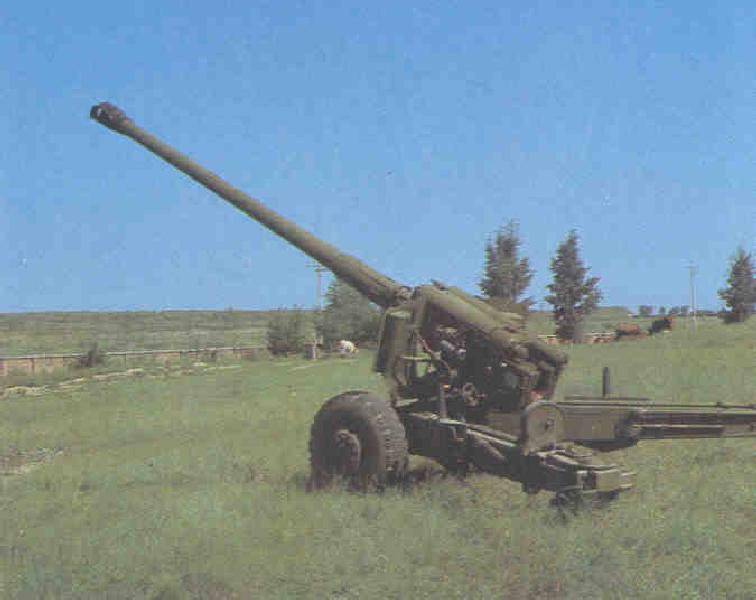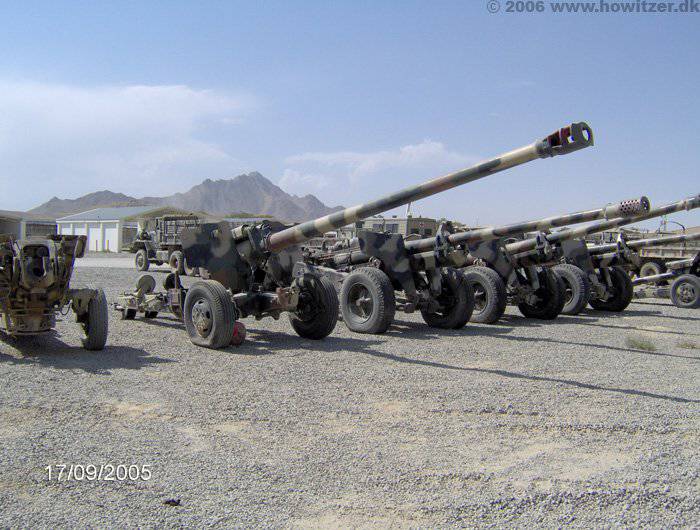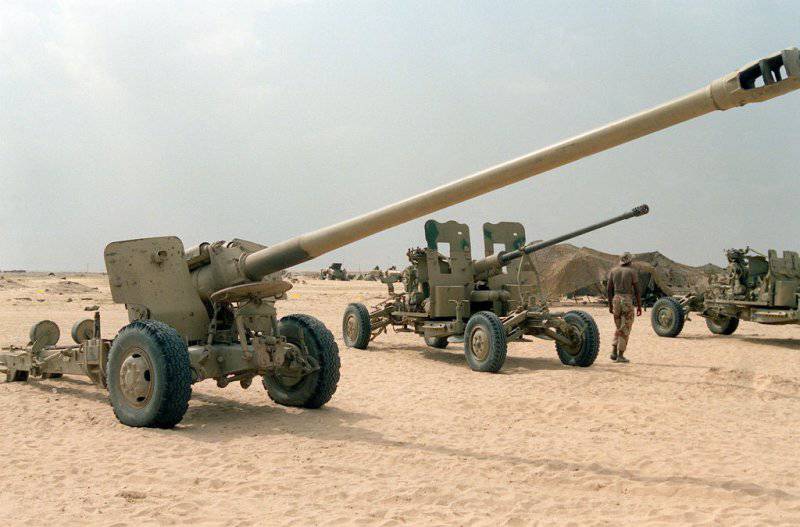122 mm D-74 cannon
23.12.1954 was adopted by the Resolution of the Council of Ministers of the USSR No. 2474-1185ss.
A prototype was made in 1950 year. Tests were conducted from 1953 to 1955 years. Mass production started in 1956 year.
The Soviet Army in the late 1940s needed to replace the 122mm A-19 (M1931/37) cannon, which was hastily developed and produced in small quantities until 1945. The A-19 was deemed too heavy and had too short a range of fire to fight artillery. As a result, the 130-mm M-46 field gun was adopted, but the design bureau under the leadership of Petrov was put into production in small quantities. Subsequently, it was this gun, which first appeared in the army in 1955, that received the designation 122-millimeter field gun D-74.
The D-74 gun is used for:
- destruction (suppression) of artillery, mortars, and also other fire weapons;
- destruction (suppression) of manpower;
- destruction of self-propelled guns and heavy tanks enemy;
- destruction of long-term and field defenses;
- suppression of governing bodies of search and rear of the enemy.

The D-74 barrel is installed on the same carriage as the D-20 howitzer-gun, a conventional two-wall carriage with a pallet and a stove designed for hanging wheels in the firing position. With this plate, the gun quite quickly and easily turned to 360 degrees. A long barrel, having a length of about 50 caliber, was equipped with a double-slot muzzle brake. The 122 millimeter cannon D-74 has a relatively small shield and is equipped with additional wheels at the ends of the bed, which simplifies maintenance.
The gun consists of a gun carriage and a barrel with a semi-automatic shutter.
The design of the barrel of the gun includes a pipe, breech, cover, holder and muzzle brake.
Valve - wedge, vertical, with semiautomatic copying (mechanical) type.
In order to prevent the projectile from falling out of the barrel when the gun is loaded at high elevation angles, a retainer is provided in the wedge tray, which is automatically lowered at the end of the shutter opening and does not prevent the sleeves from being thrown out.
For the first loading of the gun, the shutter is manually opened using the shutter handle, which is located on the breech on the right side.
The shot is made by a trigger located on the breech on the left side.
The carriage consists of: a cradle, anti-recoil devices, an upper machine with a balancing mechanism and guidance mechanisms, a lower machine with a pallet and adjustable beds, suspension and movement, shield cover and sighting devices.
The cradle is cylindrical, cast, consists of two castings paired with each other.
Inside the cradle there is a barrel, which is guided by the bronze inserts, which are attached when rolling and rolling back, which are attached to the cradle walls. On it are installed: the sector of the lifting mechanism, rods of the recoil device, the brackets of the semi-automatic copier and sight, as well as the fence with the descent.
Recoil devices - knurled and rollback brake. Nakatnik - hydro-pevmatic, filled with nitrogen or air and steol M. M. The nádnik contains 13,4 l of liquid. Initial air pressure 61 atmosphere. The recoil brake is of a spun type, hydraulic, has a spring compensator, is completely filled with steol M in the amount of 14,7 l.
The knurler cylinders and recoil brakes are fixed in the barrel clip. The upper machine is the base of the oscillating part of the tool. It is a casting, which is fixed in the trunnions of the lower machine. It has a shield, balancing and lifting mechanisms. On the left side, the bearing bracket of the swivel mechanism is welded. The sector lifting mechanism is located on the left. The transmission of force to the pinion shaft, which is engaged with the cradle sector, is carried out through a worm and conical pair. The screw turning mechanism is located to the left of the gun. One support of its pair is fixed in a bearing, which is located in a bracket welded to the left cheek of the upper machine, the second - in the left frame in the hinge pin.

The balancing mechanism is pneumatic, push type. Consists of two columns (left and right). The traverse is articulated on the upper machine with the help of pins and axes through the adjustment mechanism. The adjustment mechanism makes it possible to regulate the pressure in the columns when the ambient temperature changes within ± 17,5 C. To equalize the pressure in the columns, the internal cavities are interconnected by a tube through a valve device. The balancing mechanism is filled with air or nitrogen. Normal pressure at maximum elevation angle is 53 atmospheres ±5 atmospheres. In order to ensure the normal operation of the collar, Steola M is poured into the balancing mechanism in a volume of 0,15 liters with the addition of 20-30 grams of graphite P.
Lower machine - the basis for the rotating part of the gun. Beds are attached to the lower machine at the hinges and the casing with the bearing housing is welded. The axles of the undercarriage of the gun are placed inside the machine, torsion bushings are inserted in the axis, which are connected to the torsions. Their other ends are their slots in the cranks located in the bearing housing.
A pallet is installed on the lower machine, which is a support in the firing position, which ensures the stability of the gun during the shot. To transfer the gun between traveling and combat positions, there is a hydraulic jack installed in the traverse of the pallet. The pallet in the stowed position is folded up, and interlocks with the grips of the cradle. The pallet in this form secures the barrel during transportation.
Adjustable bed - welded, box-shaped. Both beds are the same. The hinges that connect the frame and the lower machine by means of the fingers are welded to the front ends of the boxes. Winter coulters are welded to the rear ends of the box, in which there is one through hole, which serves for the eccentric rollers of the folding coulters for summer use.
A pneumatic brake receiver is installed inside the left frame. On articulated guides, on each frame there is one lightweight opener, which is used only in winter conditions when firing from a beam. This ensures the stability of the gun in the horizontal plane. The beds in the stowed position are fastened with a cap screed to each other. The pivot beam, which is fixed between the frames with the help of special brackets with grippers, serves to connect the gun to the tractor. The pivot beam in the combat position leans back on a special hinge and stops on the beds. Podkhobotovye rollers and rack jacks are reinforced on the outside of the trunk part of each frame.
Rack jacks serve to facilitate raising the trunk of the gun during coupling (disengagement) from the tractor and placing it on the underarm rollers. In addition, to transfer the gun from traveling to combat position and vice versa. Underarm rollers are designed for rolling the D-74 over short distances, as well as turning 360 ° on a ball bearing. Summer folding openers are used to stop the trunk part of the gun during firing from soft ground. Summer coulters in the stowed position and when firing from winter coulters are folded back to the bed boxes and locked with handles through eccentric rollers.
Suspension and movement. For the D-74 cannon, YaAZ-200 wheels with GK 1200x20 tires are used. The hubs of the left and right wheels differ in the direction of the thread on the studs, which are designed to mount the wheels. Shoe type brakes are located inside the wheel disks. The gun wheels are braked using a manual or pneumatic drive. Torsion suspension during firing from the wheels is not turned off.
Sights - mechanical sight S-71 with art. panorama and OP-2 (direct sight). Both sights are located on the left of the cradle and are fixed on the bracket. The OP-2 sight is permanently attached to the gun and is removed only during a long transition or during long-term storage of the D-74. The mechanical C-71 is permanently fixed; the panorama is removed for storage in a special box. Sights for firing at night are supplied with Luch-S71M lighting.
The right and left half of the shield form a shield cover that is attached to the upper machine. In addition, the cover includes a movable shield attached to the cradle, a lower flap attached to the lower machine.
A guard down is attached on the left side of the cradle. On the fence there is a re-cocking handle of the firing pin, a trigger mechanism, a ruler of the kickback pointer and a crawler, as well as a schedule for testing the gurney.
The types of ammunition used by the D-74 are basically the same as those used by other 122-millimeter artillery systems with cartridge loading, however, the power of the propellant charge may vary. The maximum firing range is 24 thousand meters. The D-74 cannon, as is customary with Soviet artillery systems, can be used to destroy armored targets. For this, an armor-piercing projectile weighing 25 kilograms with a solid core is used, capable of penetrating 185-mm armor at a distance of a thousand meters. Today, however, ammunition of this type in artillery systems is considered obsolete and is practically not used.
Although the D-74 in the SA part came in limited quantities (possibly still in reserve), most of the guns were exported to Vietnam, Egypt, China, Cuba and North Korea. One batch of guns was even delivered to Peru, and the D-74 gun made such a strong impression on the Chinese that they set up their own similar guns, which received the designation 122-mm Type 60 gun.
Tactical and technical data X-NUMX-millimeter cannon D-122:
Caliber - 122 millimeter;
Barrel length - 6450 millimeters (52,9 caliber);
Firing range: direct shot - 850 m (1040 m), OFS - 24 thousand m;
The initial velocity of the projectile - 885 m / s;
The angle of horizontal guidance - 58 degrees;
The angle of vertical guidance is from -5 to + 45 degrees;
Charging - separate-sleeve;
Target rate of fire - up to 7 shots per minute;
Sights: direct sight OP-2-97 (OP4-97, OP4М-97, OP4М-97К), mechanical sight C-71 with artillery panorama;
Weight in the fighting position - 5,5 thous. Kg;
Mass in the stowed position - 5,55 thous. Kg;
The mass of the barrel with a muzzle brake and bolt - 2336 kg;
Shutter weight - 96 kg;
Length in the stowed position - 8690 (9875) mm;
Width in the stowed position - 2400 (2350) mm;
Height in the stowed position - 2000 mm;
The height of the line of fire - 1220 mm;
Normal rollback length - 910 mm;
The maximum length of the rollback - 950 mm;
The volume of fluid in the brake rollback - 14,7 l;
The initial pressure in the patch is 61 kgf / cm2;
The volume of fluid in the thumb stick is 13,4 L;
The transition time from marching to martial status - from 2 to 2,5 minutes;
Calculation - 10 people;
Traction - artillery tracked tractor or truck (6x6);
Towing speed: off-road - 15 km / h, cobble - 30 km / h, on the highway - 60 km / h.
Ammunition:
High-explosive projectile.
Initial speed - 885 m / s.
Weight - 27,3 kg.
Armor-piercing projectile.
Weight - 25 kg.
Penetration (at an angle of 60 degrees):
At a distance of 500 m - 170 mm;
At a distance of 1000 m - 160 mm;
At a distance of 1500 m - 150 mm;
At a distance of 2000 m - 140 mm.
The countries currently in service are Vietnam, Egypt, Peru, North Korea, China, Cuba.

Information